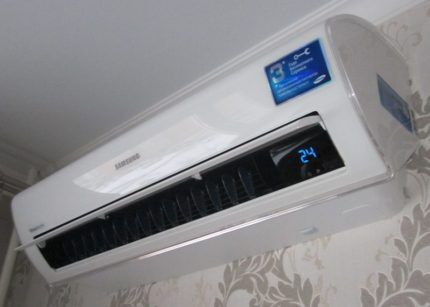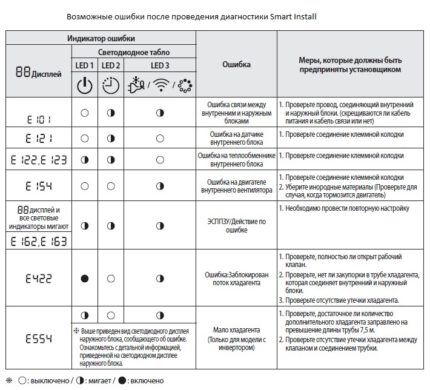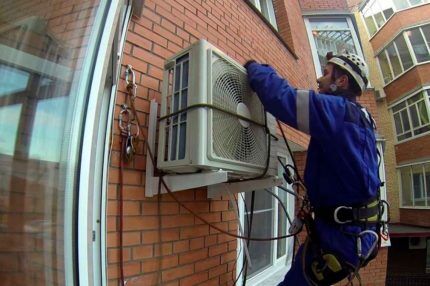Samsung air conditioner errors: how to identify a malfunction using the code and fix the problem
Air conditioning systems from the Korean manufacturer are quite reliable devices, but sometimes difficulties occur in their operation. In order to protect equipment from serious damage and help correctly diagnose problems, all Samsung air conditioner errors are displayed on the display.
The split system informs the user about its problems using special alphanumeric codes or by flashing LED indicators in a certain sequence. In order to understand what failure occurred, you need to know what this or that code means.
We will tell you what errors can occur with climate control equipment of this popular brand and what combinations of letters and numbers will appear on the device’s display.
The content of the article:
Error reporting principle
To increase the reliability of the device and prevent serious breakdowns, Samsung air conditioners are equipped with a self-diagnosis system that continuously checks several parameters of the device’s operation.
If at least one of the specified parameters is outside the norm, the device reports this in two ways:
- On the display of the indoor unit there is a combination of the letter E and three numbers, for example, E101;
- On the LED display of the outdoor unit, by lighting yellow, green and red diodes in various combinations.
The indoor units of some air conditioner models are not equipped with a display.They report their problems in the same way as outdoor units, by flashing buttons of different colors.

Below we will talk about the codes displayed by Samsung air conditioners in the event of a malfunction on the display or indicator board. Knowing the decoding of these alphanumeric combinations will allow you to understand what problems arose in the split system.
Where to start troubleshooting?
Modern air conditioners are intelligent electronic devices whose operation is controlled by a built-in processor. It is he who analyzes information coming from many sensors, recognizes faults and displays their codes.
Errors that occur can be one-time, for example, a power surge in the network, or long-term, for example, a short circuit in the fan windings. In order to understand what the nature of the malfunction is, the first thing you need to do is restart the power supply. It will reboot the air conditioning control systems and reset the signals from the sensors.

To restart, you must unplug the device for 30 seconds and then turn it back on. If the error in operation was a one-time one, then its code will disappear from the screen or indicators and the device will start working again. If the malfunction is serious, the error will appear again and its root cause will need to be eliminated.
Digital codes on the indoor unit
Displaying an error code on the display of the indoor unit is the most convenient way to convey information to the owner of the air conditioner.
The display consists of two digits and looks like 88. In the operation and repair manual it is also called “88 display”. At the same time, such a display can show only one letter and one number, or two numbers. At the same time, error codes always consist of one letter E and three numbers.
The coded combination is displayed on the display in two stages: the first and second parts of the code are shown alternately. For example, sequentially lit values E1 and 21 indicate error E121.
If the letter E and numbers appear on the display, you just need to find the decoding of this meaning. For Samsung air conditioners, there are more than 30 error codes on 88 displays.
E101 – the outdoor unit does not respond to the indoor unit for more than 1 minute (no connection). It is necessary to check the correct connection of the power and control cables between the units, as well as the absence of short circuits between their cores. This can be done by visual inspection and using a multimeter.
E121 – error in the operation of the room temperature sensor. You need to check the terminal connection of the sensor to the board. If the contact is normal, the sensor will need to be checked. To do this, you need to measure its resistance with a multimeter: at a temperature of 25OC it should be 10±3% kOhm. If there is a discrepancy, the sensor must be replaced.

E122, E123 – error of the temperature sensor, which monitors the temperature of the heat exchanger of the indoor unit. It is checked and eliminated in the same way as error E121.
E154 – problems with the internal fan motor. Check the contact between the terminal block and the board. Make sure there is nothing obstructing the fan rotation.
E162, E163 – error in making settings in the air conditioner memory. The malfunction is eliminated in several ways, depending on the severity of the violation. First, unplug the air conditioner from the outlet for 30 seconds, then plug it back in and press the ON button. If this does not help, then you need to re-configure the device.
E186 – MPI error. To fix it, contact the service center.
E202 – communication between blocks is broken. Integrity needs to be checked air conditioner routes and cables connecting the blocks, reliable contact in the terminal blocks.
E221 – problems are reported by the air temperature sensor installed in the outdoor unit: open or short circuit. Check the connector, wire and sensor.

E237 – the temperature sensor of the outdoor unit coil has triggered. Allow the device to cool down and restart the power supply.
E251 – the compressor discharge temperature is not monitored: sensor break or short circuit. The sensor and its circuit must be checked.
E416 – protective shutdown of the compressor based on air discharge temperature. It is necessary to turn off the air conditioner and let the outdoor unit cool down.
E422 – the movement of the refrigerant is blocked.Make sure that the operating valve is open and that there is no blockage in the pipes connecting the indoor unit to the outdoor unit. Make sure there is no leakage.
E440 – prohibition of heating operation at outdoor temperatures above those specified in the device passport. The heating function cannot be used until the outside temperature is within acceptable limits. This is not a breakdown, but a protective function.
E441 – prohibition of operation of the cooling system at ambient temperatures below those specified in the manual. The device is working properly, but do not turn on the cooling until the outside temperature rises to the manufacturer's allowable temperature.
E458 – reports problems with the outdoor fan. Check the fan connector. Use a multimeter to measure whether voltage is supplied to the fan. Check the wires between the blocks and their connectors.
E461 — the compressor does not start. It is necessary to check whether voltage is supplied to the compressor and whether its windings are working properly.
E462, E484 – exceeding the permissible current of the outdoor unit. Turn off the power and turn it on again after 30 seconds. Check that both units are installed correctly and that there are no obstructions to the air flow to or from the fans.
Check the integrity and connection of wires between blocks. Check whether the compressor service valve is fully open. If these measures do not help, then the compressor will most likely need to be replaced. Contact service.

E464 – exceeding the permissible current of the power module.Unplug the device for 30 seconds and turn it on again. Check the integrity and connections of all wires to the fans and compressor. Make sure there is nothing obstructing both units' fans from spinning and air flowing through them.
Check that the refrigerant pipes between the units are installed correctly. Open the compressor service valve fully. Measure the voltage on the compressor, as well as the resistance of its windings to an open circuit and to the housing. Inspect the compressor to see if it has any malfunctions and if it is making any unusual noises.
E465 – error (overload) of the compressor. Check the compressor as with error E464. If the compressor is OK, the inverter may need to be replaced.
E466 – voltage deviation in the network exceeds permissible limits. Check the voltage level, integrity of the wires and reliability of connections in the power supply network, and the correct connection of the power cable to the air conditioner. Make sure the fuses in the device are intact.
E467 - compressor operation error. Restart the air conditioner power supply. Check the compressor wire and connector. Listen, won't you? in compressor operation extraneous sounds. Measure the resistance of the compressor windings for open circuits and short circuits to the housing: if faulty, replace the compressor.
E468 – the current sensor has tripped. Restart power.
E469 – error in the DC voltage sensor of the inverter reactor. Contact a service center staffed by manufacturer-certified repair technicians.
E471 – OTP error. With this code, you need to contact the service.
E472 – problems with the AC line. Try restarting the power supply; if that doesn’t help, contact a specialist.

E473 – the compressor is blocked.
E554 – depressurization and refrigerant leakage have occurred. Restart the power with a 30 second power off. If the problem persists, check the correct installation, connection and serviceability of the EWA sensor, and make sure that the service valve is open.
The cause of the error may be incorrect installation of the air conditioner elements, as well as the connecting pipes between them, or damage to the elements through which the refrigerant moves. If a faulty part is found to be leaking, it must be replaced and the device recharged.
E556 – error in the capacity of the refrigerant pipes.
If all the numbers and lights on the panel blink at the same time, this is an error in the air conditioner settings. It is necessary to perform the same actions as for codes E162, E163.
LED indication on an outdoor device
The outdoor unit is equipped with its own error display, which is designed to simplify the task of diagnosis and repair. Indication is made using a display consisting of yellow, green and red LEDs. Each diode has three states: off, on and flashing. Different light combinations indicate certain errors.

Most of these errors correspond to codes on the 88 display and duplicate its readings. However, there are codes that are only displayed on the LED display.
Smart Install Automatic Test Mode
In the latest series of its AR air conditioners, Samsung has introduced an automatic analysis mode for correct installation "Smart Install". Its purpose is to diagnose the health of all systems before first use.
This function will be useful if you install the equipment yourself or want to check whether the air conditioner was installed correctly by a specialized organization.
To start Smart Install, the air conditioner must be switched to “standby” mode, and the [Set/Cancel or Cancel], [Mode], [Power] keys must be held simultaneously on the remote control for 4 seconds. After starting the test mode, you will no longer be able to use the control panel.
Automatic verification takes 7-13 minutes. The progress of execution is displayed on the 88 display with values from 0 to 99, and on the LED display by sequential and then simultaneous blinking of the LEDs. If the test result is positive, the air conditioner will inform you about this with a sound signal, and the control panel will start working again.
If the check reveals errors, their code will be indicated on the display or LED display.

Knowing the error code, fix the identified problems yourself or contact a service center.
Safety precautions for self-service
An air conditioner is a technically complex household appliance, the warranty of which applies only if installed and serviced by organizations specializing in the repair of household appliances.It is better to entrust the work to them.
In addition, installation of an outdoor unit often associated with increased danger when working at height and often requires the use of safety equipment for high-altitude repairs or equipment with a working platform moving at height.

If you decide to do the work yourself, then follow the necessary safety precautions:
- Read the instructions in detail;
- During maintenance and repair of the air conditioner, disconnect it from the power supply;
- If repairs require measurements on a device connected to the network, then use a serviceable tool with protective electrical insulation, do not touch live or rotating parts;
- Do not make changes to the device’s operation scheme, do not replace protective sensors with “plugs”;
- Observe safety precautions when working at height.
In everyday life, it is not always possible to identify all faults, much less eliminate them.
Nevertheless, if you have certain skills, it is quite possible to check the correct connection and integrity of the wires. You can test the presence of contact in connectors and clamps, the serviceability of temperature sensors, perform cleaning and other work.

To perform such simple operations, you should have in your household at least Phillips and slotted (flat) screwdrivers of medium and small sizes, pliers, wire cutters, a multimeter, and a wire for making jumpers. Depending on the model, you may need the appropriate wrenches and hex keys.
Conclusions and useful videos on the topic
The video tells that the cause of error E101 was the appearance of a microcrack on the printed circuit board in the street block:
The video shows the cleaning of an outdoor air conditioner unit and its dismantling:
As you can see, thanks to the developed system of diagnostics and fault indication, you can determine the cause of the failure of the Samsung air conditioner yourself. The first thing you need to do is disconnect the split system from the electrical network for 30 seconds to reset the errors.
Also, before turning the device back on, it is better to make sure that the outdoor unit has no mechanical damage. To identify and eliminate more serious faults, you will need to have a decoding of error codes and the necessary tools on hand. And some errors require a mandatory call to service.
Would you like to talk about your own experience in identifying a failure of your own split system? Do you know any technological nuances that are worth sharing with site visitors? Please write comments in the block form below, post pictures and ask questions about the topic of the article.



